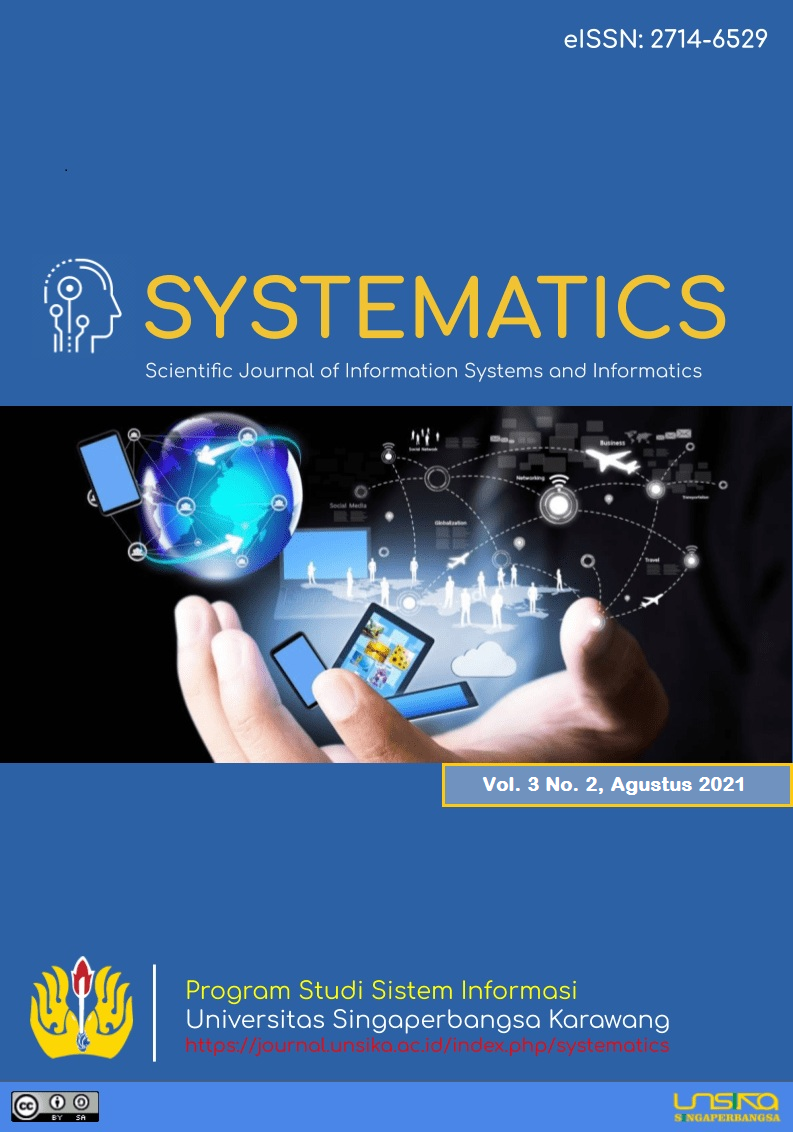Web Application for the Best Teacher Decision Making System Using the AHP Method at SMA Al-Binaa Bekasi
Aplikasi Web untuk Pengambilan Keputusan Guru Terbaik Sistem Menggunakan Metode AHP di SMA Al-Binaa Bekasi
Abstract
Elementary school level education, junior high school, high school is the main work of teachers,
schools are very interested in maintaining the quality of teachers in the teaching and learning
process. The process of selecting the best teachers that have been regulated in the guidelines for
outstanding teachers and goals, among others, is to increase the motivation, dedication, loyalty and
professionalism of teachers, which is expected to have a positive effect on improving education at the
school level to the national level. In the teacher's guideline with achievement and referring to the
teacher's criteria, it must refer to Pedagogic Competence, (2) Professional Competence, (3) Personal
Competence, (4) Social Competence. SMA IT ALBINAA currently does not have a process to maintain
teacher quality, so to overcome this, form a Forum Group Discussion (FGD) SMA IT ALBINAA to
standardize the criteria for selecting the best teachers in the hope of motivating teachers to be even
better. After that, an information system is designed which is presented by building a decision support
system using the Analytical Hierarchy Process (AHP) method as a method that can process data from
the criteria that have been disclosed in the Forum Group Discussion (FGD) including Attendance,
Discipline, RPP, Education Level, Number of hours teach. After that, the system will provide
recommendations for the best teacher level at SMA IT ALBINAA based on the calculation of the
Analytical Hierarchy Process (AHP) followed by the final stage of testing with the Black Box testing
method.
Downloads
References
Rini F, “Sistem Pendukung Keputusan Pemilihan Guru Terbaik Pada SMK Islam Al-Arif Muaro
Jambi,” Vol 8(2), Jurnal Akademika, 2016, pp. 7-13.
Jaya E., A, “Sistem Pendukung Keputusan Penentuan Pemilihan Guru Berprestasi Pada SMKN 1
Sutera Kabupaten Pesisir Selatan Menggunakan Metode Analytic Hierarchy (AHP) Dengan
Iplementasi Bahasa Pemograman PHP dan MySql,” Vol 10 (1), Jurnal Teknologi Informasi dan
Pendidikan, 2017, pp. 72-83.
Burnelly M, Introduction to the Analytic Hierarchy Process, New York: Springer, 2015.
Siddiq D., F, & Septyan E, “Analisis Perbandingan Metode AHP dan SAW Dalam Penilaian
Kinerja Karyawan (Strudi Kasus Di PT Grafindo Media Pratama Bandung),” Vol 10(2), Jurnal
Lpkia, 2017, pp. 1-7.
Lestari E, “Kolaborasi Metode SAW dan AHP Untuk sistem Pendukung Keputusan Penilaian
Kinerja Asisten Laboratorium,” Vol 9(1), Jurnal Sistem Infromasi (JSI), 2017, pp. 1204-1215.
Fishburn, P.C, “A Problem-based Selection Of Milti-Attribute Decision Making Methods,” New
Jersey : Balck Well Publishing.
MacCrimmon, K.R, ”Decision Making Among Multiple Atribut Alternatives : a Surfay and
Consolidated Approuch”.
Marimin, “Sistem Pendukung Pengambilan Keputusan dan Sistem Pakar”, IPB, 2014.
Saaty, T.L, “How To Make a Decision: The Analytical Hierarchy Process,” European Journal Of
Oprational Research.
Lubis S, M., & Harahap U. N, “Penerapan Metode SAW dan AHP Secera Komparatif Untuk
Menentukan Kinerja Pegawai Sekolah Tinggi Teknik Harapan,” Vol 3(30), 2014.
Putra S. A., Hidayat N., & Muflikhah L, “Rekomendasi Pemilihan Properti Kota Malang
Menggunakan Metode AHP-SAW,” Vol 1(10), Jurnal Pengembangan Teknologi Informasi dan
Ilmu Komputer, 2017, pp.1201-1209.
Tim Kementerian Riset Teknologi dan Pendidkan Tinggi Direktorat Jendral Sumber Daya IPTEK
dan Pendidikan Tinggi, “Pedoman Pemilihan Dosen Berprestasi Kategoti Sains Dan Sosial
Humaniora,” Jakarta, 2017.
Downloads
Published
How to Cite
Issue
Section
License
Copyright (c) 2021 SYSTEMATICS

This work is licensed under a Creative Commons Attribution-ShareAlike 4.0 International License.
Authors who publish with this journal agree to the following terms:
- Authors retain copyright and grant the journal right of first publication with the work simultaneously licensed under a Creative Commons Attribution-ShareAlike 4.0 International License. that allows others to share the work with an acknowledgement of the work's authorship and initial publication in this journal.
- Authors are able to enter into separate, additional contractual arrangements for the non-exclusive distribution of the journal's published version of the work (e.g., post it to an institutional repository or publish it in a book), with an acknowledgement of its initial publication in this journal.
- Authors are permitted and encouraged to post their work online (e.g., in institutional repositories or on their website) prior to and during the submission process, as it can lead to productive exchanges, as well as earlier and greater citation of published work (See The Effect of Open Access).







